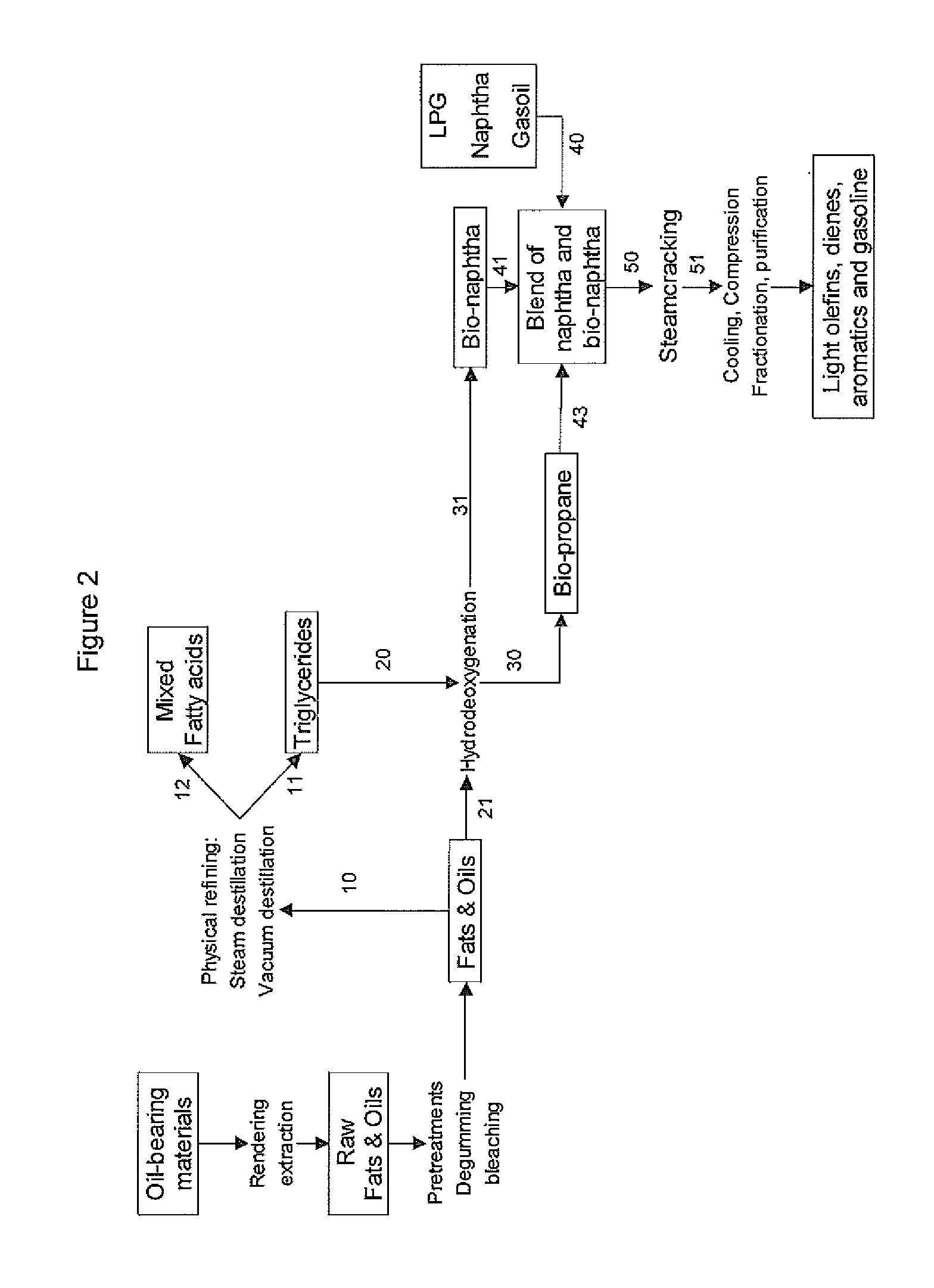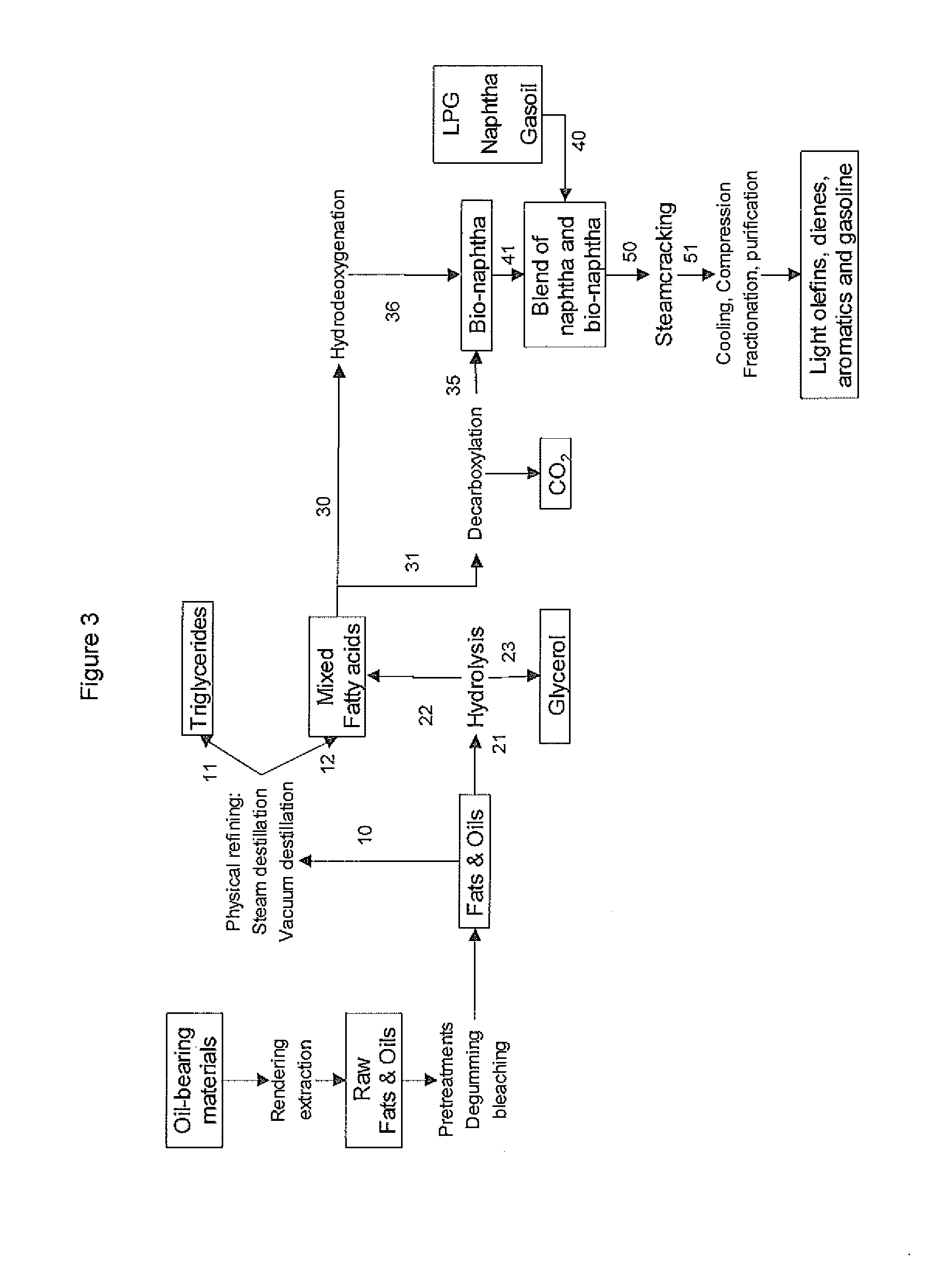Process for the production of bio-naphtha from complex mixtures of natural occurring fats and oils
a technology of bionaphtha and complex mixtures, which is applied in the direction of fatty oil/acid recovery from waste, fatty oil/fat refining, hydrocarbon oil treatment products, etc., can solve the problems of excessive fouling, corrosion problems, and existing steamcrackers that are not designed to remove high amounts of carbonoxid
- Summary
- Abstract
- Description
- Claims
- Application Information
AI Technical Summary
Benefits of technology
Problems solved by technology
Method used
Image
Examples
example 1
Hydrodeoxygenation of a Triglyceride Feed has been Evaluated Under the Following Conditions
[0114]In an isothermal reactor, 10 ml of a hydrotreating catalyst composed of Molybdenum and Nickel supported on alumina (KF848 obtained from Albemarle) was loaded, the catalyst dried and pre-sulfurized under standard conditions with straightrun gasoil doped with DMDS.
[0115]The hydrodeoxygenation of rapeseed is done at:
[0116]LHSV=1 h−1
[0117]Inlet Temperature=320° C.
[0118]Outlet pressure=60 bars
[0119]H2 / oil ratio=630 N1 / l
[0120]Feedstock=rapeseed doped with 1 wt % DMDS
[0121]Table 4 shows a typical composition of the rapeseed oil.
[0122]The gas and liquid effluent are separated by means of a separator (gas / liquid) at atmospheric pressure. Gases are sent to a μ-GC analyser and liquids are sent to a sampler. The mass balance is around 99% and all product weights are calculated for 100 g of treated feed.
TABLE 4Typical composition of rapeseed oilComponentswt %tetradecanoate0.1hexadecenoate0.2hexadeca...
example 2
[0126]n-Paraffin's and conventional naphtha have been steamcracked under different severity conditions. Table 6 gives the results. It is evident from the results that such-obtained bio-naphtha are better feedstock for steamcracking compared to fossil naphtha.
[0127]Significant higher ethylene and propylene yields can be obtained whereas the methane make and the pyrolysis gasoline make is reduced with at least about 20%. The ultimate yield of HVC (High value Chemicals=H2+ethylene+propylene+butadiene+benzene) is above 70 wt %. Ethylene / Methane weight ratio is always above 3.
TABLE 6Naphthan-Decanen-C15n-C20Naphthan-Decanen-C15n-C20P / E0.590.440.500.490.500.390.440.44COT812812812812832832832832S / HC0.350.350.350.350.350.350.350.35Summarywt % (dry)wt % (dry)wt % (dry)wt % (dry)wt % (dry)wt % (dry)wt % (dry)wt % (dry)Hydrogen0.870.660.590.570.960.760.690.67Methane14.7911.6710.6510.0016.2512.8011.8011.15Acetylene0.250.250.250.250.360.370.370.37Ethylene25.3938.8736.2435.8226.9139.6736.9336.47E...
PUM
 Login to View More
Login to View More Abstract
Description
Claims
Application Information
 Login to View More
Login to View More - R&D
- Intellectual Property
- Life Sciences
- Materials
- Tech Scout
- Unparalleled Data Quality
- Higher Quality Content
- 60% Fewer Hallucinations
Browse by: Latest US Patents, China's latest patents, Technical Efficacy Thesaurus, Application Domain, Technology Topic, Popular Technical Reports.
© 2025 PatSnap. All rights reserved.Legal|Privacy policy|Modern Slavery Act Transparency Statement|Sitemap|About US| Contact US: help@patsnap.com



